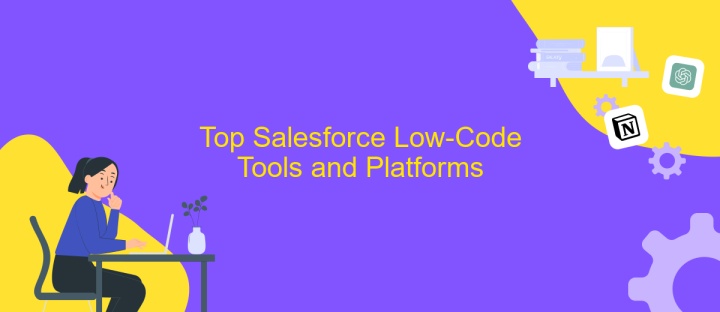Salesforce Low-Code
In today's fast-paced digital landscape, businesses are seeking agile solutions to streamline their operations and innovate rapidly. Salesforce Low-Code emerges as a powerful tool, enabling organizations to build applications with minimal coding effort. By leveraging intuitive drag-and-drop interfaces and pre-built components, teams can accelerate development processes, reduce costs, and empower non-developers to contribute to digital transformation initiatives, driving efficiency and growth.
Understanding Salesforce Low-Code: Empowering Business Users
Salesforce Low-Code is revolutionizing the way businesses approach application development by enabling non-technical users to create powerful solutions with minimal coding. This approach empowers business users to address specific needs quickly and efficiently, bridging the gap between IT and business units. By leveraging intuitive drag-and-drop interfaces and pre-built components, organizations can accelerate digital transformation and reduce dependency on traditional development cycles.
- Empowers users to create custom applications without extensive coding knowledge.
- Reduces development time and costs by utilizing pre-built templates and components.
- Facilitates collaboration between IT and business teams, enhancing productivity.
- Enables rapid prototyping and deployment, fostering innovation and adaptability.
By adopting Salesforce Low-Code, companies can streamline their operations and respond swiftly to market changes. This democratization of app development allows for a more agile business environment, where users can continuously iterate and improve solutions. Ultimately, Salesforce Low-Code not only enhances operational efficiency but also drives innovation by empowering business users to take an active role in shaping their digital landscape.
Key Benefits of Salesforce Low-Code Development

Salesforce Low-Code Development offers a transformative approach for businesses looking to streamline their application development processes. By minimizing the need for extensive coding knowledge, it empowers a broader range of employees to contribute to software creation, thus accelerating development timelines and reducing costs. This democratization of app development allows organizations to rapidly respond to changing market demands and innovate with agility. Moreover, the intuitive drag-and-drop interface simplifies the design process, enabling users to create robust, scalable applications tailored to their unique business needs without the traditional bottlenecks associated with complex coding.
Another significant benefit is the seamless integration capabilities that Salesforce Low-Code Development provides. By leveraging platforms like ApiX-Drive, businesses can effortlessly connect various applications and automate workflows, enhancing operational efficiency. This integration capability ensures that data flows smoothly across systems, providing real-time insights and fostering informed decision-making. As a result, organizations can optimize their operations, improve customer experiences, and maintain a competitive edge in an increasingly digital landscape. Overall, Salesforce Low-Code Development is a strategic asset for any business aiming to innovate quickly and efficiently.
Top Salesforce Low-Code Tools and Platforms

Salesforce offers a variety of low-code tools and platforms that empower businesses to develop applications with minimal coding effort. These tools are designed to streamline the development process, enabling users to create custom solutions that meet their specific needs efficiently. By leveraging these tools, organizations can accelerate their digital transformation journey and enhance productivity.
- Salesforce Lightning App Builder: A drag-and-drop interface that allows users to create custom apps and pages quickly without extensive coding knowledge.
- Process Builder: This tool enables users to automate business processes by creating workflows and setting up complex logic with a simple point-and-click interface.
- Flow Builder: A powerful automation tool that allows users to build complex business processes using a visual interface, reducing the need for manual coding.
- Einstein Next Best Action: Provides AI-driven recommendations and actions to enhance decision-making and improve customer interactions.
These Salesforce low-code tools and platforms are instrumental in empowering users to innovate rapidly while maintaining flexibility and control over their business processes. By adopting these solutions, organizations can reduce development time, lower costs, and drive better outcomes for their customers.
Real-World Examples of Salesforce Low-Code Success

Salesforce Low-Code has revolutionized the way businesses approach app development, enabling companies to create robust solutions with minimal coding expertise. One standout example is a retail company that streamlined its inventory management process using Salesforce's low-code tools. By developing a custom application, they reduced errors and improved efficiency, leading to a 20% increase in operational productivity.
Another success story involves a healthcare provider that leveraged Salesforce Low-Code to enhance patient engagement. They built a patient portal that allowed seamless scheduling and communication, resulting in improved patient satisfaction and a 15% reduction in administrative workload.
- A financial services firm developed a compliance tracking app, cutting audit preparation time by 30%.
- An education institution created a student feedback system, boosting response rates by 40%.
- A non-profit organization automated donor management, increasing donations by 25%.
These examples highlight how Salesforce Low-Code empowers diverse industries to innovate and optimize their operations. By enabling rapid application development, businesses can adapt quickly to changing needs, enhance customer experiences, and achieve measurable outcomes without the need for extensive coding resources.
- Automate the work of an online store or landing
- Empower through integration
- Don't spend money on programmers and integrators
- Save time by automating routine tasks
Getting Started with Salesforce Low-Code: Tips and Resources
Embarking on your journey with Salesforce Low-Code is an exciting opportunity to streamline your business processes with minimal coding. Start by familiarizing yourself with Salesforce's intuitive interface, which allows you to create applications using simple drag-and-drop tools. Explore Trailhead, Salesforce's free online learning platform, offering modules tailored to low-code development. These resources will help you understand the fundamentals and best practices for building efficient apps.
Once comfortable with the basics, enhance your Salesforce Low-Code experience by integrating third-party services. For seamless integrations, consider using ApiX-Drive, a versatile tool that simplifies connecting Salesforce with other applications without extensive coding. ApiX-Drive offers pre-built connectors and a user-friendly interface, ensuring a smooth integration process. Leverage this tool to automate workflows and synchronize data across platforms, maximizing the potential of your Salesforce Low-Code solutions. As you progress, continue exploring community forums and attending webinars to stay updated on the latest trends and tips in low-code development.
FAQ
What is Salesforce Low-Code?
How can I automate workflows in Salesforce using Low-Code?
Can I integrate third-party applications with Salesforce using Low-Code?
What are the benefits of using Low-Code in Salesforce?
Is Salesforce Low-Code suitable for complex applications?
Apix-Drive is a simple and efficient system connector that will help you automate routine tasks and optimize business processes. You can save time and money, direct these resources to more important purposes. Test ApiX-Drive and make sure that this tool will relieve your employees and after 5 minutes of settings your business will start working faster.


